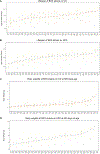Gene-by-environment modulation of lifespan and weight gain in the murine BXD family
- PMID: 34552269
- PMCID: PMC8478125
- DOI: 10.1038/s42255-021-00449-w
Gene-by-environment modulation of lifespan and weight gain in the murine BXD family
Abstract
How lifespan and body weight vary as a function of diet and genetic differences is not well understood. Here we quantify the impact of differences in diet on lifespan in a genetically diverse family of female mice, split into matched isogenic cohorts fed a low-fat chow diet (CD, n = 663) or a high-fat diet (HFD, n = 685). We further generate key metabolic data in a parallel cohort euthanized at four time points. HFD feeding shortens lifespan by 12%: equivalent to a decade in humans. Initial body weight and early weight gains account for longevity differences of roughly 4-6 days per gram. At 500 days, animals on a HFD typically gain four times as much weight as control, but variation in weight gain does not correlate with lifespan. Classic serum metabolites, often regarded as health biomarkers, are not necessarily strong predictors of longevity. Our data indicate that responses to a HFD are substantially modulated by gene-by-environment interactions, highlighting the importance of genetic variation in making accurate individualized dietary recommendations.
© 2021. The Author(s), under exclusive licence to Springer Nature Limited.
Conflict of interest statement
Figures







References
-
- Kuningas M et al.Genes encoding longevity: from model organisms to humans. Aging Cell 7, 270–280 (2008). - PubMed
Publication types
MeSH terms
Grants and funding
LinkOut - more resources
Full Text Sources

